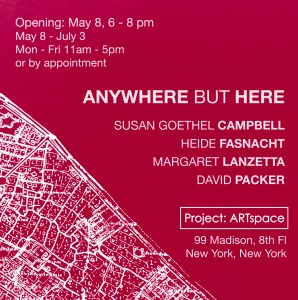
Contributed by Becky Huff Hunter / It�s a common story of contemporary art for artists to describe abandoning the two-dimensional confines of traditional painting on canvas for the more immediate materiality of sculpture, installation, or performance. In her 2016 memoir, for example, academy-trained painter�Marina Abramovi?�recalls her decisive moment: �Why should I limit myself to two dimensions when I could make art from anything: fire, water, the human body?��New York-based painter Ginny Casey recently described a far less storied move in the opposite direction at an artist talk at the Institute of Contemporary Art (ICA), University of Pennsylvania, where her work is currently exhibited.

Casey initially worked as a sculptor and turned to painting so that she could create the kind of surreal environments that she imagined but was not physically capable of building. According to the gallery text, she now �builds sculpture with paint.� Her strange still lifes depict the tools and materials of a sculptor�s studio � knives and scissors, cuts of wood and lumps of clay, electric fans and ceramic vases � along with other, uncanny additions.
The eleven�medium-to-large oil on canvas works on display at ICA inhabit a fairly large gallery: some of them are propped up on a long platform, others hang on false walls that feature rectangular cutout doorways. The set-up reminded me of painter Louise Fishman�s 2016 micro-survey at ICA, which sought to evoke the artist�s studio within the museum. (Chief Preparator Paul Swenbeck worked on both exhibitions� designs.)

In Moody Blue Studio, 2017, each depicted object �pink-and-blue table, black scissors, terracotta figure, hovering brown disembodied hands � appears to have been carefully outlined, painted in, and then outlined again. There are no paint drips or other markers of accident; there are hardly even identifiable brushstrokes because the painting�s surface has been sanded down to a uniform flatness, invoking a deliberate, uneasy calm. Layered blotches of color create mottled, muted dimensionality. The objects ground each other, as each of them touches at least one other object. The joined-up group floats, unanchored by shadow, against the vast dream space of the painting�s royal blue studio floor and cobalt walls. A single rectangular doorway, lit from below, pierces the dark wall and echoes the cutout doorways in the exhibition design.
This impossible composition, as well as�those of the other ten�paintings, is reminiscent of art school still life problem sets: geometric and sculptural objects studiously set at rakish angles fill each canvas to its edges, playing with positive and negative spatial relationships, perspective, and proportion. In this way, Casey�s works at first appear invitingly straightforward. And yet they become increasingly mysterious in their handling of paint, color, and subject matter. Complementary colors placed in layers and adjacent to each other bring out the shimmer and glow of saturated oil color.

A case in point, Pressing Matter, 2015, comprises magenta rubbery rings, a gunmetal grey knife, and olive green and lilac fingers with lemon yellow fingernails against a navy backdrop. A disembodied hand hangs languidly in thin air, massaging a squashed ball of clay; dark eyes peep out of a clamshell box and watch a single (middle?) finger sticking straight up in a daring pose. This severed icon of defiance seems to celebrate painting�s powers of invention as much as sculpture�s connection to the three dimensional world.
“Ginny Casey & Jessi Reaves,” Institute of Contemporary Art, Philadelphia, PA. Through August 6, 2017.
About the author:�Becky Huff Hunter�is�an independent writer, editor, and researcher, who regularly covers Philadelphia-area contemporary art in�Artforum. She has�written for�Frieze,�Sculpture, and�Art Papers, as well as numerous exhibition catalogue essays,�and she works as�a staff writer at the University of Pennsylvania.
Related posts:
Body parts: Clarity Haynes, Catherine Haggarty and Ginny Casey
Ginny Casey�s recurring sensations
Painting IRL: 2013 Bushwick Open Studios















